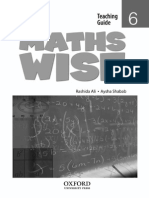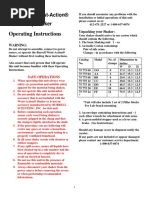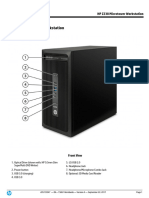Module 6
Uploaded by
api-291246438Module 6
Uploaded by
api-291246438Grade 3, Module 6
Core Focus
Working with the eights, ones, and zeros multiplication facts
Solving word problems involving multiplication
Working with fractions using the number line and area models
Exploring fraction families, the additive nature of fractions, and improper fractions
using fraction strips
Multiplication
Ideas for Home
Mastery of multiplication and division requires more than just memorization.
In Grade 3, fact families are introduced in a logical order, building on what
students already know, so working with the facts makes sense.
Practice the eights doubling
facts, e.g. What is 8 x 7?
Instead of stopping at 56,
ask your child to explain by
doubling. I know that double
7 is 14, double 14 is 28, and
double 28 is 56, so 8 x 7
is 56.
In this module, doubling/halving strategies for the twos and fours multiplication/division
facts are extended to the eights facts using double double double.
2
Take turns to make up fact
stories with zero and ones
facts: e.g. 4 x 0, 4 crayon
boxes were emptied of
crayons, how many crayons
were left to use? Or 1 x 5:
There was one package of
cookies
with 5 in it.
Introducing the Eights Multiplication Facts
8
This arrow diagram shows how using the double double double strategy supports learning
the 8 facts. Double 6 is 12, double 12 is 24, and double 24 is 48, so 6 8 = 48.
Ones and zeros facts are some of the last multiplication facts introduced. While easy
for adults, it is challenging for students to visualize x0 as no groups with some in
each group, or x1 as one group with no repeating.
6.1
Look at this array. What do you see?
26=
=62
What strategy can you use to figure out the product?
6.6
Reinforcing the Ones and Zeros Multiplication Facts
Tyler planted seedlings in one row of 6.
How many seedlings did he plant? How do you know?
Claire had 6 packets of stickers. She gave stickers to each
of her friends until the packets were empty.
Glossary
Look at the next array. What do you see?
What strategy can you use to figure out the product?
26=
=62
46=
=64
26=
=62
46=
=64
86=
=68
Arrays are dot arrangements
I used the double, double strategy.
that show the rows and
Look at the next array. What do you see?
columns
in a
How can
you use the fours expressed
fact to help you
figure out the product for the eights fact?
multiplication
sentence.
8 sixes is the same as
double 6.
Theydouble,
aredouble,
useful
for
Is this an easy strategy to use?
What other
eights
facts
could
you
solve
using
strategy?
representing the this
double
double double strategy.
How many stickers did Claire have left? How do you know?
a.
b.
c.
double 9
Rita had 6 pencils on her desk.
Then her friend gave her another pencil.
double, double 9
29=
Gavin had 6 mushrooms on his plate.
He ate none of them.
128
49=
ORIGO Education.
double, double, double 9
How many pencils did Rita have in total? How do you know?
89=
ORIGO Stepping Stones 3 6.1
ORIGO Education.
How many mushrooms did Gavin eat? How do you know?
What can you say about the math involved in each story?
In this lesson, students think about situations that have either one or zero groups,
or one or zero in each group.
1
120815
Grade 3, Module 6
Fractions
To visualize fractions, students fold paper strips, shade some parts, and then label
with a fraction. The bottom number (denominator) tells how many pieces are folded
into the whole strip, while the top number (numerator) tells how many of those
pieces are shaded.
1
1
2
1
2
1
4
1
4
1
8
1
8
1
4
1
8
1
8
1
4
1
8
1
8
1
8
1
8
This model shows how paper strips can be folded to represent related fractions.
Students also visualize fractions using a number line. The denominator tells how
the distance between whole numbers (0 to 1, or 1 to 2, etc.) is split up; the numerator
tells the count of hops along those dividing marks.
3
When the numerator and denominator are the same ( 3 ), the fraction is equal to 1.
10
Fractions that are greater than 1 ( 3 ) are called improper fractions*, which can be
4
1
rewritten as mixed numbers ( 3 = 1 3 ).
Ideas for Home
Practice counting by unit
fractions. E.g. to measure
1 34 cups of our, use a 41 cup
unit to count: 41 , 24 , 34 , 44 , 54 , 64 , 47
in 1 34 .
Cut a rectangular pan of
food into rows and columns
of equal portions (brownies,
lasagna, corn bread, etc.)
Count the portions by unit
fractions. E.g. if a pan of
lasagna is cut into 12 pieces
count the pieces of the total
lasagna: 1 , 2 , 3 , etc to 12 .
12 12 12
12
When it is time to clean up,
ask your child how much
lasagna is left and to express
it by counting in unit fractions.
What fraction could you write to show the total amount of banana?
+
1
3
1
3
1
3
1
3
2
3
What do you notice about the fraction
Glossary
1
3
4
3
5
3
A unit fraction is a proper
fraction that has 1 as the
numerator. For example,
1 1 1 1
2 , 3 , 4 , 5 . All fractions are
composed of unit fractions:
1
1
1
3
e.g. 5 + 5 + 5 = 5 .
4
?
3
The numerator is greater than the denominator.
4
I can see on the number line that 3 is greater than 1.
In this lesson, the number line is used to explore fractions greater than 1.
Each whole is divided into thirds; 4 hops = 34 .
Students show specic improper fractions, rst with the number line model and then
explore how these new fractions can be represented with an area model.
Fractions greater than 1 can also be shown with shapes.
Each large square on the right is one whole.
Each whole is split into four parts of equal size.
How many fourths are shaded in total?
What fraction is shown?
ORIGO Education.
In this lesson, students use area models to think about fractions that
are greater than 1.
* While
10
3
is called an improper fraction, this type of fraction is acceptable to write
and use in mathematics.
2
120815
You might also like
- Everyday Math Grade 3 Unit 5 Study Guide PAPERNo ratings yetEveryday Math Grade 3 Unit 5 Study Guide PAPER18 pages
- Innovations in Portland Cement Manufacturing80% (5)Innovations in Portland Cement Manufacturing1,283 pages
- CKMath G5U3 MultiplyingAndDividingFractions SR W2No ratings yetCKMath G5U3 MultiplyingAndDividingFractions SR W299 pages
- Kami Export - G4.M5.v3.1.3.0w - Teacher - EditionNo ratings yetKami Export - G4.M5.v3.1.3.0w - Teacher - Edition629 pages
- Year 8 Autumn 3 Multiplying and Divisding Fractions Exemplar Questions and AnswersNo ratings yetYear 8 Autumn 3 Multiplying and Divisding Fractions Exemplar Questions and Answers64 pages
- Eureka Math Grade 3 Module 3 Parent Tip Sheet 1100% (1)Eureka Math Grade 3 Module 3 Parent Tip Sheet 12 pages
- Grade 3, Unit One: Computation, Algebraic Thinking & ProbabilityNo ratings yetGrade 3, Unit One: Computation, Algebraic Thinking & Probability2 pages
- Eureka Mathtips For Parentsgrade 3 Module 3100% (1)Eureka Mathtips For Parentsgrade 3 Module 32 pages
- Mms4 Textbook Unit3 MultiplicationanddivisionNo ratings yetMms4 Textbook Unit3 Multiplicationanddivision42 pages
- Number and Operations: Mathematics Grade 3No ratings yetNumber and Operations: Mathematics Grade 38 pages
- Math5 Q1 Mod6 Multiplicationoffractions-1No ratings yetMath5 Q1 Mod6 Multiplicationoffractions-122 pages
- Grade 8 Lesson 2 Fractions Multiplication Division100% (2)Grade 8 Lesson 2 Fractions Multiplication Division13 pages
- AVID Cornell Notes -Fractions & DecimalsNo ratings yetAVID Cornell Notes -Fractions & Decimals12 pages
- 2017 3rd Grade Math Pacing Guide TrimestersNo ratings yet2017 3rd Grade Math Pacing Guide Trimesters3 pages
- Yeoh Chew Lan IPGM Kampus Temenggong IbrahimNo ratings yetYeoh Chew Lan IPGM Kampus Temenggong Ibrahim45 pages
- CPA-MULTIPLICATION AND DIVISION OF FRACTION USING CPA APPROACH AMSDIGA (Autosaved)No ratings yetCPA-MULTIPLICATION AND DIVISION OF FRACTION USING CPA APPROACH AMSDIGA (Autosaved)59 pages
- 'Arrays, Multiplication and Division' Printed From: Show MenuNo ratings yet'Arrays, Multiplication and Division' Printed From: Show Menu33 pages
- Booklet Math Tips For Parents 6 Plus PDF USNo ratings yetBooklet Math Tips For Parents 6 Plus PDF US16 pages
- Unit and Lesson Plan For Grade 7 (13 and 14 Years Old Students)No ratings yetUnit and Lesson Plan For Grade 7 (13 and 14 Years Old Students)9 pages
- Math-G3-M1-Topic-E-Lesson-16 Lesson PlanNo ratings yetMath-G3-M1-Topic-E-Lesson-16 Lesson Plan11 pages
- Grade 3 Multiplication and Divison Unit PlanNo ratings yetGrade 3 Multiplication and Divison Unit Plan4 pages
- Grade 3, Module 1: 1 Ten 5 Ones 3 Hundreds 6 Ones 7 Hundreds 3 TensNo ratings yetGrade 3, Module 1: 1 Ten 5 Ones 3 Hundreds 6 Ones 7 Hundreds 3 Tens2 pages
- Overview of Mergers and Acquisition and MNo ratings yetOverview of Mergers and Acquisition and M11 pages
- [FREE PDF sample] Parsforte Internazionale de arte 3rd Edition Parsforte International Amiramin Sharifi ebooks100% (3)[FREE PDF sample] Parsforte Internazionale de arte 3rd Edition Parsforte International Amiramin Sharifi ebooks50 pages
- MAN Truck 2012 Emergency Responders GuideNo ratings yetMAN Truck 2012 Emergency Responders Guide86 pages
- A Case Study On MUET High Achievers' Results Cohort 2012/13No ratings yetA Case Study On MUET High Achievers' Results Cohort 2012/1359 pages
- C1 - Writing help - Informal letters (1)No ratings yetC1 - Writing help - Informal letters (1)20 pages
- Transcription of Echtrae Chonnlai-McConeNo ratings yetTranscription of Echtrae Chonnlai-McCone3 pages
- International Relations Syllabus - Hudakova - 2020No ratings yetInternational Relations Syllabus - Hudakova - 20204 pages
- Versatile, Feature-Rich Production Routing!: Multicam 3000 Series CNC Router Feature and Specification GuideNo ratings yetVersatile, Feature-Rich Production Routing!: Multicam 3000 Series CNC Router Feature and Specification Guide7 pages
- Revised Blooms Taxonomy Process Verbs Assessments and Questioning StrategiesNo ratings yetRevised Blooms Taxonomy Process Verbs Assessments and Questioning Strategies2 pages
- Lesson Exemplar For Handicraft ProductionNo ratings yetLesson Exemplar For Handicraft Production2 pages
































































































